At a Nov. 15th phone justice rally in Washington D.C., we, along with our partners at SumOfUs, delivered signatures from 36,690 people across the country calling on the FCC to rein in predatory prison phone rates. And it looks like the FCC will act soon -- Commissioner Mignon Clyburn announced that the FCC Chairman has circulated a prison phone regulatory proposal that the commission will now vote on.
by Leah Sakala,
November 15, 2012
At a Nov. 15th phone justice rally in Washington D.C., we, along with our partners at SumOfUs, delivered signatures from 36,690 people across the country calling on the FCC to rein in predatory prison phone rates. And it looks like the FCC will act soon — Commissioner Mignon Clyburn announced that the FCC Chairman has circulated a prison phone regulatory proposal that the commission will now vote on.

We worked with Josh Begley to create an info graphic showing that the states that bar the most people from the polls are likely to be the same states that cast the deciding vote for president on November 6, 2012
by Leah Sakala,
October 30, 2012
We worked with Josh Begley to create an info graphic showing that the states that bar the most people from the polls are likely to be the same states that cast the deciding vote for president on November 6, 2012
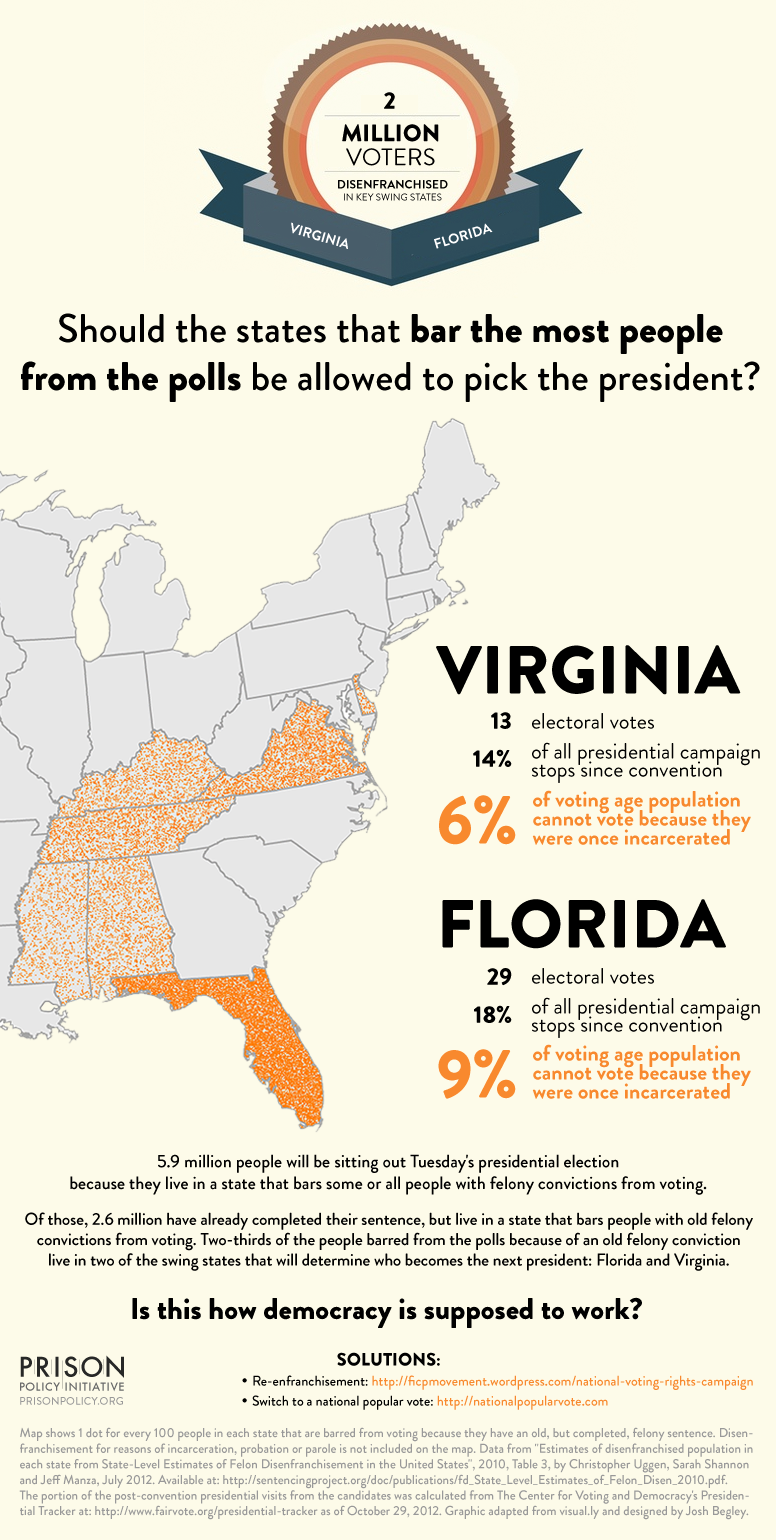
The New York Times cited "The Price to Call Home: State-Sanctioned Monopolization in the Prison Phone Industry" in an editorial calling on the Federal Communications Commission to cap prison calling rates.
by Leah Sakala,
September 24, 2012
 The New York Times cited “The Price to Call Home: State-Sanctioned Monopolization in the Prison Phone Industry” in an editorial calling on the Federal Communications Commission to cap prison calling rates.
The New York Times cited “The Price to Call Home: State-Sanctioned Monopolization in the Prison Phone Industry” in an editorial calling on the Federal Communications Commission to cap prison calling rates.
A new Prison Policy Initiative report reveals that the monopolistic prison phone industry’s high calling rates are jeopardizing public safety and taxing poor communities. The report calls on the FCC to set price caps that would allow incarcerated people to increase their chances of success upon release by staying connected to their families.
by Leah Sakala,
September 11, 2012
 A new Prison Policy Initiative report reveals that the monopolistic prison phone industry’s high calling rates are jeopardizing public safety and taxing poor communities. The report calls on the FCC to set price caps that would allow incarcerated people to increase their chances of success upon release by staying connected to their families.
A new Prison Policy Initiative report reveals that the monopolistic prison phone industry’s high calling rates are jeopardizing public safety and taxing poor communities. The report calls on the FCC to set price caps that would allow incarcerated people to increase their chances of success upon release by staying connected to their families.
An analysis of racial disparity in NYC's stop and frisk numbers also reveals the diminishing returns of the policy.
by Peter Wagner,
May 10, 2012
This piece was originally prepared as one in a series of guest posts for the Prison Law Blog.
New York City’s “stop and frisk” policing strategy is getting a lot of attention. A police officer notes a “reasonable suspicion,” whatever that is, and then stops the person, asks some questions and then often frisks him or her.
It’s not hard to see where allegations of racial profiling come from. It’s the subject of a class action lawsuit, and last week 20 people, including Cornel West, were convicted for a civil disobedience protest last year against stop and frisk.
“Stop and frisk” is a major NYC initiative that is growing:
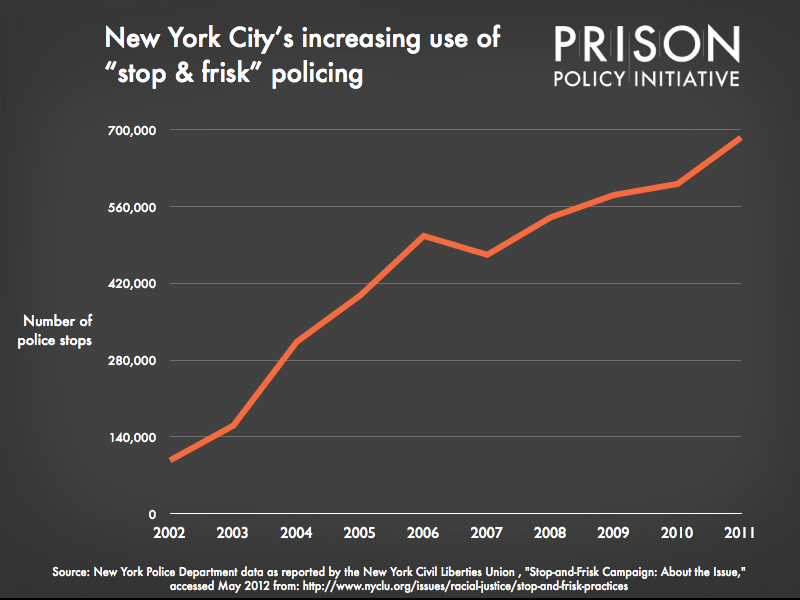
The majority of the people being stopped and frisked are Black and Latino, and that’s been a consistent fact:
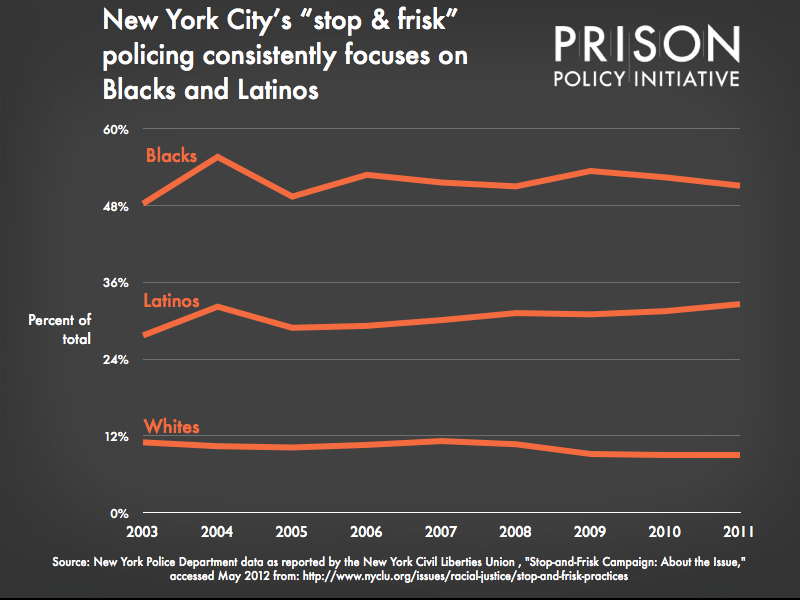
A lot of the news coverage has been less than effective in explaining the racial disproportionality in New York City’s stop and frisk. For example, Blacks are 52% of stops, but 23% of the population. Latinos are 31% of stops, but 29% of the population. Whites are 9% of the stops and 33% of the population. The eyes of 90% of the readers of this paragraph have glazed over and I suspect that 100% of the people reading aren’t quite sure exactly what the significance is.
The most useful comparison is to compare the relative number of people in each racial and ethnic group who are stopped by the police in a given year. Now it’s quite clear just how big the problem is:
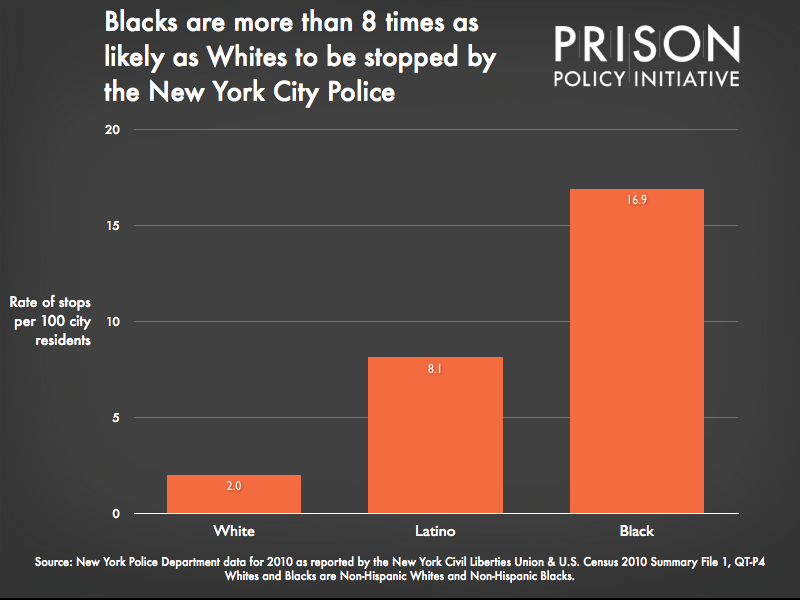
Blacks in New York City are 8 times as likely to be stopped by the police as Whites. And the disparity gets larger when we look at just stops that result in frisks:
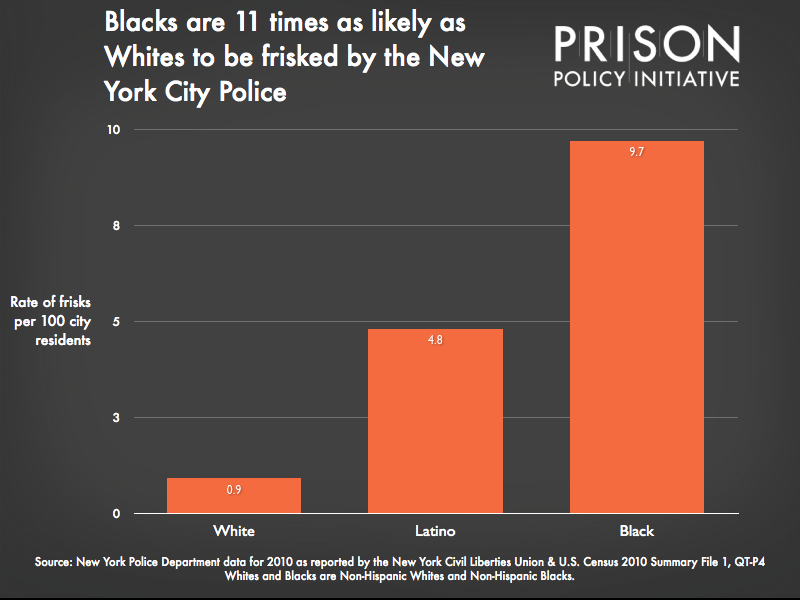
And even larger still when we look at police stops that result in the use of force:
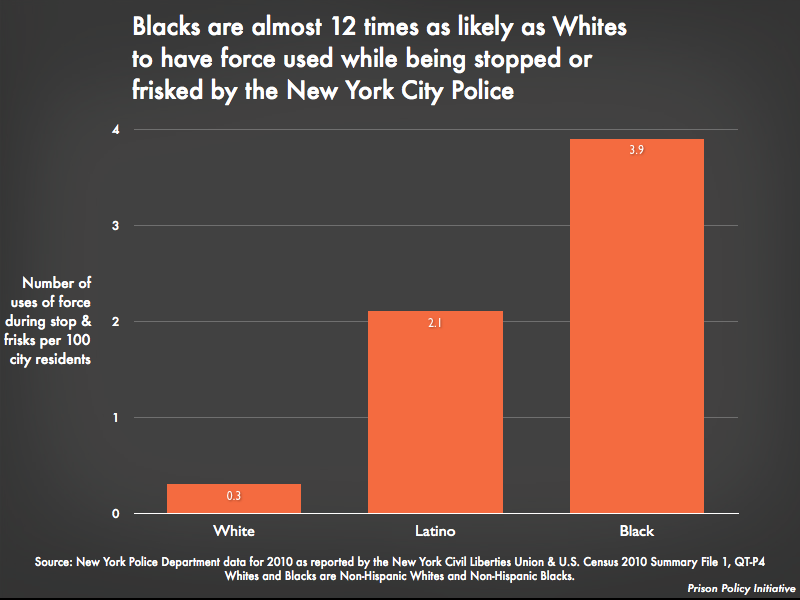
The disparity in the use of force isn’t warranted by differential rates of offending, as we found that Latinos and Blacks were more likely than Whites to experience the use of force without being arrested.
The different experiences of Blacks, Latinos and Whites with stop and frisk are no doubt part of why ending stop and frisk is a priority for Black and Latino voters, but not for politicians who want White support.
And what do New Yorkers get for giving up their civil liberties? It’s not a lot in the way of public safety. 93% of the stops in 2010 did not result in arrest, and the majority of the arrests were for petty offenses. And guns, the main justification for “stop and frisk”? Guns are found in a tiny portion of the stops, about 1 out of every thousand stops in 2011. And the trend isn’t positive. While the police point to the tiny annual increase in the number of gun seized, the percentage of stops that result in a gun being found is plummeting:graph showing that while the number of guns seized during stop and frisks has grown a little from 2003 to 2011, the portion of stops that result in a gun seizure has plummeted:

I have no doubt that good police work can find illegal guns. Wholesale “stop and frisk,” though undermines Black and Latino trust in the police without improving public safety. That’s a poor investment in police resources.
Mayor Bloomberg is famous for his big-business style fixation on data and on seeing a high return on investment. Yet, for some reason, he has been reluctant to hold policing strategies up to that same cost vs. results standard. Will his successors be any different?
[* Updated on May 18, 2012 to use Census figures that more closely correspond with how the NYPD assigns people to a race and ethnicity and to add graphs about the racial disparity in frisks and in the use of force.]
The author is Executive Director of the Prison Policy Initiative. This article is one in a series of short articles exploring under-discussed facts about the criminal justice system.
Peter Wagner has a new guest post on the Prison Law Blog, Supply-side murder control?, about the gun lobby's support for laws like "Stand Your Ground" and the connection between handgun production and handgun homicides.
by Leah Sakala,
April 12, 2012

Peter Wagner has a new guest post on the Prison Law Blog, Supply-side murder control?, about the gun lobby’s support for laws like “Stand Your Ground” and the connection between handgun production and handgun homicides.
by Leah Sakala,
April 5, 2012
Please vote for the Prison Policy Initiative in a social change contest to win $2500 from GOOD Maker! We want to launch a fact sheet series to give criminal justice reform advocates the tools they need to create change. The proposal is inspired by our 2003 project The Prison Index.
The vigilante ethos behind 'Stand Your Ground' has very little to do with legitimate fears of crime.
by Peter Wagner,
March 30, 2012
The recent killing of unarmed African-American 17-year-old Trayvon Martin in Florida by a leader of a Community Watch program is sparking an overdue discussion about race, crime and Florida’s “stand your ground” law that makes it easier to shoot someone and claim self-defense.
The vigilante ethos behind “Stand Your Ground” has very little to do with legitimate fears of crime.
Check out this graph, which shows that African-Americans are almost twice as likely as Whites to be victimized by burglary, yet African-Americans support making it harder to access guns. African-Americans aren’t the advocates of laws that make it easier to use a weapon.

So which politically powerful group has the lowest incidence of burglary? Those with the most money:

There is no question that having your home burglarized is traumatic and harmful. But we need responses to societal problems that make us safer. Neither vigilantism nor mass incarceration fit the bill. And in a truly just system, the communities that pay the highest price for crime would play the largest role in determining how we should address crime.
As the tragedy of Trayvon Martin shows, letting fear drive social policy makes us all less safe.
by Leah Sakala,
January 17, 2012
At the 1/16 GOP primary debate Juan Williams cited PPI’s data in a question he asked about the issue of racial disparities in drug-related arrests and convictions:


 The New York Times cited “
The New York Times cited “ A
A 











